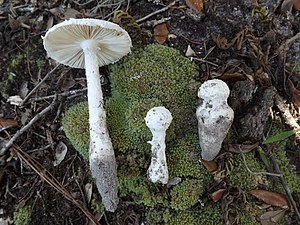Amanita longipes
| Amanita longipes | |
|---|---|

| |
| Several Amanita longipes fungi found growing at Ocala National Forest, Marion Co., Florida, United States. | |
| Scientific classification | |
| Kingdom: | Fungi |
| Division: | Basidiomycota |
| Class: | Agaricomycetes |
| Order: | Agaricales |
| Family: | Amanitaceae |
| Genus: | Amanita |
| Species: | A. longipes
|
| Binomial name | |
| Amanita longipes Bas ex Tulloss & Dav.T. Jenkins
| |
| Amanita longipes | |
|---|---|
| Mycological characteristics | |
| cap is umbonate | |
| hymenium is free | |
| spore print is white | |
| ecology is mycorrhizal | |
| edibility: inedible | |
Amanita longipes is a small inedible mushroom species of the Amanita genus. It feeds on decaying leaves of some woods and can be found around the Appalachian Mountains. It is a food source for various insects.
Contents
Description
Cap
The cap is typically around 24 – 102 mm (2.4 - 10.2 cm) wide, is hemispheric at first then becoming broadly convex to plano-convex, occasionally also slightly depressed in center; white, pallid grayish-brown or grayish buff over disk in age, surface dull and tacky at first and becoming shiny.
Gills
The gills are usually narrowlyadnate, sometimes with a decurrent line, close, whitish, becoming grayish-cream on drying, with white, floccose remnants of partial veil on edges, narrow, 4.5 – 11 mm (0.45 - 1.1 cm) broad, sometimes anastomosing; the short gills are truncate to rounded truncate to attenuate to attenuate in steps, plentiful, of diverse lengths, unevenly distributed.
Stem
The stem is 25 - 142 (2.5 - 14.2 cm) × 5 – 20 mm (0.5 – 2 cm), white, and tapers upward slightly to a flaring apex. The stem is decorated with easily removed, floccose material especially in upper portion; the flesh of the stem usually does not take on a color when bruised. The flesh is white, occasionally graying in damaged areas, with a firmly stuffed central cylinder, up to 7 mm wide. The ring is fibrous-floccose and rapidly evanescent. Volval remnants are absent from the bulb and the stem base or difficult to distinguish.[1]
References
- ↑ http://www.amanitaceae.org/?Amanita%20longipes Retrieved October 17, 2016
| ||||||||||||||||||||||||||||||||
Error: "Q4033856" is not a valid Wikidata entity ID.
